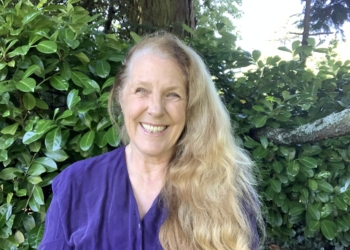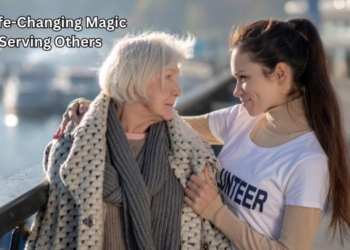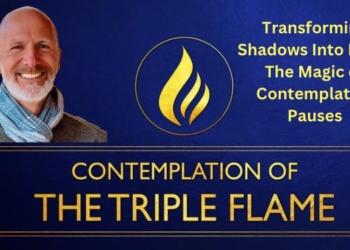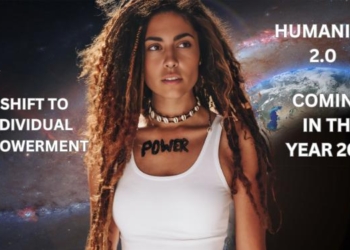 By Jonathan Haidt | greatergood.berkeley.edu
By Jonathan Haidt | greatergood.berkeley.edu
Ever feel a thrill when you see someone act with courage or compassion? Psychologist Jonathan Haidt calls that feeling “elevation,” and his studies of it may provide a key to understanding what inspires people to do good.
Here’s a puzzle: why do we care when a stranger does a good deed for another stranger? Most theories in the social sciences say that people’s actions and feelings are motivated by self-interest. So why are we sometimes moved to tears by the good deeds or heroic actions of others?
I believe we cannot have a full understanding of human morality until we can explain why and how human beings are so powerfully affected by the sight of a stranger helping another stranger. For the past several years I have studied this feeling, which I call “elevation.” I have defined elevation as a warm, uplifting feeling that people experience when they see unexpected acts of human goodness, kindness, courage, or compassion. It makes a person want to help others and to become a better person himself or herself.
Elevation is widely known across cultures and historical eras. You probably recognize it yourself. But for some reason no psychologist has studied it empirically. Instead, psychologists have focused most of their energies on the negative moral emotions, especially guilt and anger. Psychologists have thought about morality primarily as a system of rules that prevents people from hurting each other and taking their possessions.
But I believe that morality is much richer and more balanced. Most people don’t want to rape, steal, and kill. What they really want is to live in a moral community where people treat each other well, and in which they can satisfy their needs for love, productive work, and a sense of belonging to groups of which they are proud. We get a visceral sense that we do not live in such a moral world when we see people behave in petty, cruel, or selfish ways. But when we see a stranger perform a simple act of kindness for another stranger, it gives us a thrilling sense that maybe we do live in such a world. The fact that we can be so responsive to the good deeds of others—even when we do not benefit directly—is a very important facet of human nature. Yes, people can be terribly cruel, and we must continue our study of racism, violence, and other social ills. But there is a brighter side to human nature, too, and psychology ought to look more closely at it.
Beyond disgust
I started examining elevation only after years of studying its opposite: disgust. It makes good evolutionary sense that human beings should have an emotion that makes us feel repulsion toward rotten food, excrement, dead bodies, and other physical objects that are full of dangerous bacteria and parasites. It also makes sense that disgust should make us hypersensitive to contagion—that is, we feel disgust toward anything that touched something that we find disgusting.
But when my colleagues and I actually asked people in several countries to list the things they thought were disgusting, we repeatedly found that most people mentioned social offenses, such as hypocrisy, racism, cruelty, and betrayal. How on earth did a food-based and very corporeal emotion become a social and moral emotion? The short version of our attempt at an answer is that while disgust may motivate people to distance themselves from physical threats, it is well-suited for dealing with social threats as well. When we find social actions disgusting, they indicate to us that the person who committed them is in some way morally defective. In this light, we seem to place human actions on a vertical dimension that runs from our conception of absolute good (God) above, to absolute evil (the Devil) below. This vertical dimension is found in many cultures—for example, in Hindu and Buddhist ideas that people are reincarnated at higher or lower levels depending on their moral behavior in this life.
Social disgust can then be understood as the emotional reaction people have to witnessing others moving “down,” or exhibiting their lower, baser, less God-like nature. Human beings feel revolted by moral depravity, and this revulsion is akin to the revulsion they feel toward rotten food and cockroaches. In this way, disgust helps us form groups, reject deviants, and build a moral community.
I thought about the social nature of disgust in this way for years, and about what exactly it means when someone moves “down” on the vertical dimension from good to evil. But then, one day in 1997, I looked up. I had never thought about what emotion we feel when we see someone move higher on the vertical dimension, acting in an honorable or saintly way. But once I began to investigate, I saw a whole new emotional response triggered by virtuous, pure, or super-human behavior. I called this emotion “elevation” because seeing other people rise on the vertical dimension toward goodness seems to make people feel higher on it themselves. Once I began looking for elevation, I found it easily. I saw that most people recognize descriptions of it, and the popular press and Oprah Winfrey talk about it (as being touched, moved, or inspired). Yet research psychologists had almost nothing to say about it.
I have now done several experiments on elevation, and here is what I have learned.
Studying elevation
First, my students and I asked people to write in detail about five kinds of situations that we thought seemed likely to produce different kinds of positive emotions, including happiness and elevation. We then asked specific questions about their bodily changes, thoughts, actions, and motivations in these different situations. In the question that was supposed to prompt people to share their experiences of elevation, we asked participants to write about “a specific time when you saw a manifestation of humanity’s ‘higher’ or ‘better’ nature.” The stories told in response were often moving and beautiful.
The most commonly cited circumstances that caused elevation involved seeing someone else give help or aid to a person who was poor or sick or stranded in a difficult situation. A particularly powerful and detailed case captures the flavor of these situations:
Myself and three guys from my church were going home from volunteering our services at the Salvation Army that morning. It had been snowing since the night before, and the snow was a thick blanket on the ground. As we were driving through a neighborhood near where I lived, I saw an elderly woman with a shovel in her driveway. I did not think much of it when one of the guys in the back asked the driver to let him off here. The driver had not been paying much attention so he ended up circling back around towards the lady’s home. I had assumed that this guy just wanted to save the driver some effort and walk the short distance to his home (although I was clueless as to where he lived). But when I saw him jump out of the back seat and approach the lady, my mouth dropped in shock as I realized that he was offering to shovel her walk for her.
When participants saw unexpected acts of goodness like this one, they commonly described themselves as being surprised, stunned, and emotionally moved. Their descriptions imply that under the surface, they were changing their views about humanity in a more optimistic way and triggering higher goals for themselves. When asked, “Did the feeling give you any inclination toward doing something?” the most common response was to describe general desires to help others and to become a better person. Several participants described the kind of openness and urge to be playful that psychologist Barbara Fredrickson has ascribed to joy. The woman who wrote about the snow-shoveling episode above also wrote,
I felt like jumping out of the car and hugging this guy. I felt like singing and running, or skipping and laughing. Just being active. I felt like saying nice things about people. Writing a beautiful poem or love song. Playing in the snow like a child. Telling everybody about his deed.
A common theme in most of the narratives is a social focus—a desire to be with, love, and help other people. The effects of these feelings appear to have potentially life-altering effects. One participant described how moved he was when so many people came to visit and support his family while his grandfather was dying. He said he still had those feelings seven years later, and that those feelings helped inspire his decision to become a doctor. Feelings of elevation seem particularly capable of fostering love, admiration, and a desire for closer affiliation with the doer of the good deed. The woman in the snow-shoveling incident wrote,
My spirit was lifted even higher than it already was. I was joyous, happy, smiling, energized. I went home and gushed about it to my suite-mates, who clutched at their hearts. And, although I have never seen this guy as more than just a friend, I felt a hint of romantic feeling for him at this moment.
Love and a desire for affiliation appear to be a common human response to witnessing saints and saintly deeds, or even to hearing about them second hand. If disgust is a negative emotion that strengthens ego boundaries and defenses against a morally reprehensible other, then elevation is its opposite—a desire to associate with those who are morally admirable.
A second study confirmed this general portrait of elevation. This second study induced elevation in a laboratory by showing one group of participants video clips from a documentary about Mother Teresa. Control groups saw other videos, including an emotionally neutral but interesting documentary, and a comedy sequence from the television show America’s Funniest Home Videos. Compared to participants who watched the control videos, participants who watched the elevating video clip reported feeling more loving and inspired, they more strongly wanted to help and affiliate with others, and they were more likely to actually volunteer to work at a humanitarian charity organization afterwards.
In both studies, we found that participants in the elevation conditions reported different patterns of physical feelings and motivations when compared to participants in the control conditions. Elevated participants were more likely to report physical feelings in their chests—especially warm, pleasant, or “tingling” feelings—and they were more likely to report wanting to help others, become better people themselves, and affiliate with others. In both studies, reported feelings of happiness energized people to engage in private or self-interested pursuits, while feelings of elevation seemed to open people up and turn their attention outwards, toward other people.
Based on this research, I believe elevation carries many benefits, including individual benefits like the energy and playfulness of the woman in the above example. However, elevation is particularly interesting because of its social benefits—its power to spread, which could improve entire communities. If frequent bad deeds trigger social disgust, cynicism, and hostility toward one’s peers, then frequent good deeds may have a type of social undoing effect, raising the level of compassion, love, and harmony in an entire society. Efforts to promote and publicize altruism may therefore have widespread and cost-effective results. I am now looking into the possibility that elevation can be used in moral education programs, inspiring young people in ways that more traditional teaching techniques cannot.
Getting elevated
It is a surprising and very beautiful fact about our species that each of us can be moved to tears by the sight of a stranger helping another stranger. It is an even more beautiful fact that these feelings sometimes inspire us to change our own behavior, values, and goals. Narratives of the lives of Jesus, Buddha, Mother Teresa, and other inspiring figures are full of stories of people who, upon meeting the saintly figure, dropped their former materialistic pursuits and devoted themselves to advancing the mission of the one who elevated them.
Indeed, a hallmark of elevation is that, like disgust, it is contagious. When an elevation story is told well, it elevates those who hear it. Powerful moments of elevation, whether experienced first or second hand, sometimes seem to push a mental “reset” button, wiping out feelings of cynicism and replacing them with feelings of hope, love, optimism, and a sense of moral inspiration. This thought is for the moment an unsubstantiated speculation, but a clear description of such a case was recently sent to me by a man named David Whitford.
Several years ago, David’s Unitarian church asked each of its members to write his own “spiritual autobiography,” an account of how he became a more spiritual person. While reflecting on his spiritual experiences, David grew puzzled over why he is so often moved to tears during the course of church services. He concluded that there are two kinds of tears. The first he called “tears of compassion,” such as those he shed during a sermon on Mother’s Day about children who were growing up abandoned or neglected. He wrote that these cases felt to him like “being pricked in the soul,” after which “love pours out” for those who are suffering.
But the second kind of tears was very different. He called them “tears of celebration,” but he could just as well have called them “tears of elevation.” I will end this article with his words, which give a more eloquent description of elevation than anything I could write.
A few weeks after Mother’s Day, we met here in the sanctuary after the service and considered whether to become a Welcoming Congregation [a congregation that welcomes gay people]. When John stood in support of the resolution, and spoke of how, as far as he knew, he was the first gay man to come out at First Parish, in the early 1970s, I cried for his courage. Later, when all hands went up and the resolution passed unanimously, I cried for the love expressed by our congregation in that act. That was a tear of celebration, a tear of receptiveness to what is good in the world, a tear that says it’s okay, relax, let down your guard, there are good people in the world, there is good in people, love is real, it’s in our nature. That kind of tear is also like being pricked, only now the love pours in.
Article Source: greatergood.berkeley.edu














